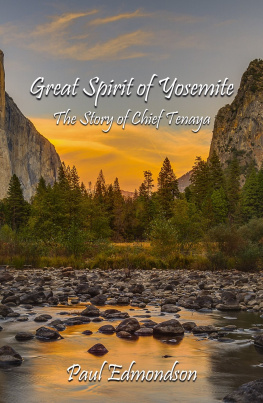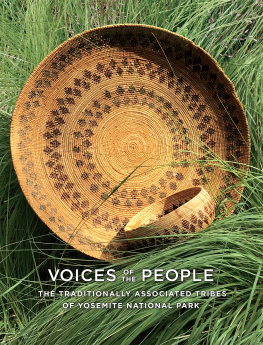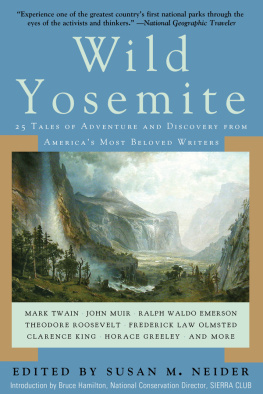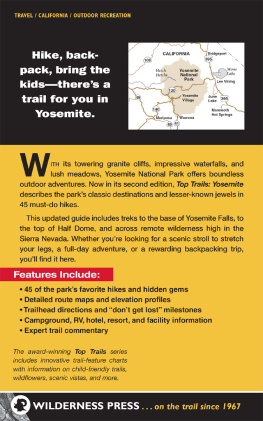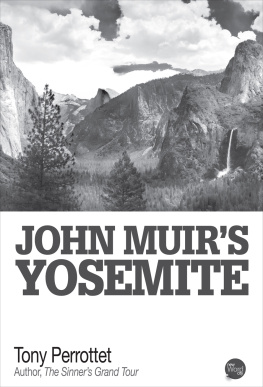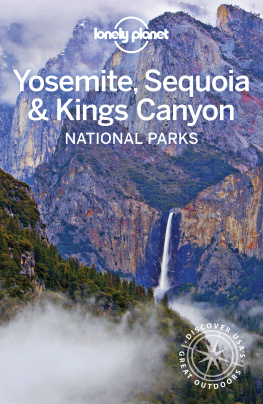Great Spirit of Yosemite
THE STORY OF CHIEF TENAYA
Great Spirit of Yosemite
THE STORY OF CHIEF TENAYA
Paul Edmondson
atmosphere press
Copyright 2020 Paul Edmondson
Published by Atmosphere Press
Cover design by Nick Courtright
No part of this book may be reproduced
except in brief quotations and in reviews
without permission from the publisher.
Great Spirit of Yosemite
2020, Paul Edmondson
10 9 8 7 6 5 4 3 2 1
atmospherepress.com
For Ursula, Natasha, Damien, Jeff and Imogen
This work is fiction, inspired, adapted and extracted from:
Lafayette H. Bunnell, Discovery of the Yosemite and the Indian war
of 1851 3rdEd.,1892, F.H. Revell Co. New York. (http://www.yosemite.ca.us/library/discovery_of_the_yosemite/)
Richard J. Hartesveldt, Yosemite Valley Place Names, 1955,
Yosemite Nature Notes. (https://www.yosemite.ca.us/library/yosemite_nature_notes/34/)
James M. Hutchins, How the Yosemite was Discovered and Named,
May 1859, Hutchings California Magazine, No. 35, 498. Hutchings and Rosenfield, San Francisco.
(https://www.yosemite.ca.us/library/hutchings_california_magazine/35.pdf)
Ralph S. Kuykendall, Early History of Yosemite Valley, The
Masterpiece of Natures Handiwork, 1919, Washington Government Printing Office
(http://www.yosemite.ca.us/library/early_history_of_yosemite_valley/)
Mrs. H.J. Taylor, The Last Survivor, 1932, Johnck & Seeger, San
Francisco.
(https://www.yosemite.ca.us/library/the_last_survivor/)
Herbert Earl Wilson, Lore and Lure of the Yosemite: The Indians,
Their Customs, Legends and Beliefs, and the Story of Yosemite, 1922, A.M. Robertson, San Francisco.
(https://www.sacred-texts.com/nam/ca/lly/)
Before a day was ever conceived as a day
before westering-sunrise warned of rain
before stars flew across skies without being seen
before signs and words turned into themselves
the Great Spirit without before or after
over countless millennia counted without numbers
woke the whole Valley into its life with a single breath
in a love that had always been
Notes on Events Leading to the Formation of the State of California and the Lead-up to the Mariposa Indian War
The main part of this story takes place in the mid-19th century in the state of California, but the origins of its indigenous people and spirit of its people carry from an earlier age.
Brief notes on the history of California will help put the storys events into context. The following timeline sets the scene for the Gold Rush, the formation of the Mariposa Battalion and the Mariposa Indian War of 1851, which events enfold this fiction.
California
California is an American place name, which includes the U.S. state of California and the Mexican states of Baja California and Baja California Sur. The origin of the name is thought to have been derived from an early 16th century Spanish novel, Las Sergas de Esplandin, where the name California was given to a mythical, Asian island inhabited by a band of black, female, Amazonian warriors, ruled by Queen Califa.
Indigenous groups lived in what is now known as the state of California up to 15,000 years before its name was given. These indigenous people were then the sole occupants of this land. More than 100 different groups, with very diverse cultures and languages, settled into their own individual territories along the coast, along rivers, in mountain valleys, bordering deserts, carrying with them their own customs, religions and beliefs.
In this story, the name California is used in its current, modern context, referring to a territory (state) that was not relevant to the indigenous people (Indians) that lived in this region for thousands of years before the name was given. It inadequately represents the array of indigenous Indian peoples and cornucopia of their history.
Timeline
1533
In 1533, a Spanish expedition led by Diego de Bercarra and Fortun Ximenez applied the name California to the tip of what is now Baja California, Mexico, believing it to be an island. The first map to use the toponym California was printed in 1562.
Spanish and English explorers arrived on the Pacific coast of California at the beginning of the 16th century, initially along the coastal area of present-day Mexico and by mid-century along the southern California coast.
1542
The first European to land on the southern Californian coast (at present-day San Diego Bay) was Juan Rodrguez Cabrillo, a Portuguese explorer sailing under the Spanish flag. He concluded that there was nothing worth exploiting in this newly discovered land. The expedition reported that they observed little in the way of developed agriculture, the Indians using implements made of wood and leather, woven baskets, tools of antler and stone; homesteads made from timber strips and mud, or holes dug into the ground, covered with animal skins and brushwood. These indigenous Indians lived in small villages of family members of 100150 people. The expedition explored little beyond the southern coastal regions. So the territory was essentially left unexplored for more than two centuries.
Index of Place Names, Meanings
and Present-day Names
The following place names referred to in this story are those used by the original dwellers in and around present-day Yosemite, California, together with their meaning in parentheses, where known, and the American names these places were subsequently given.
Ahwahnee, Ah-wah-nee, (gaping mouth), now given the name Yosemite Valley. The Indians who lived in this area were Ahwahneechees but came to be called Yosemites (grizzly bears or fierce as grizzly bears) by other groups. There were about 40 Indian camps/villages in the valley prior to the Gold Rush.
Chokoni, Cho-koni, (shade of the baby basket) became Royal Arches.
Chorlok, Chor-lok, (high fall) became Yosemite Falls.
Kayopah, Ka-yo-pah, (sky and peaks that touch) became the Sierra Nevada.
Kahwinabah, Kah-win-na-bah, became Little Yosemite Valley.
Kekotooyem, Keko-too-yem, (sleeping waters) became Mirror Lake.
Lehamite, Le-hamite, (arrow wood) became Indian Canyon.
Loiya, Loiya, (long water basket) became Sentinel Rock.
Lungootookoyah, Lung-oo-too-ko-yah, (pigeons nest) became Ribbon Falls.
Pantanko, Pan-tan-ko, became Cooks Meadow.
Pohono, Po-ho-no, (evil wind) became Bridalveil Falls. The Indians who lived in this area were known as Pohonochees.
Pompompa, Pom-pom-pa, (leaping frogs) became the Three Brothers.
Next page
